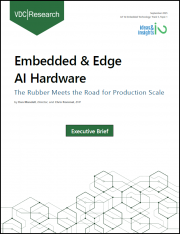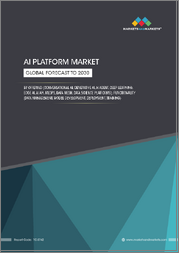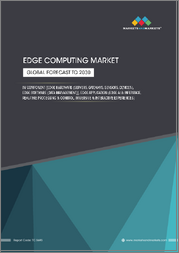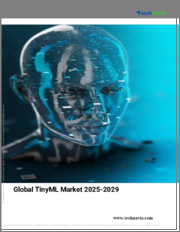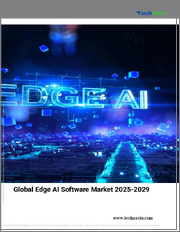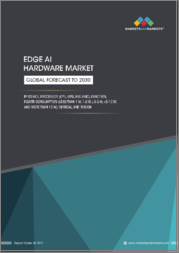
|
시장보고서
상품코드
1361415
세계의 엣지 AI 하드웨어 시장 - 산업 규모, 점유율, 동향, 기회, 예측(2018-2028년)Edge AI Hardware Market - Global Industry Size, Share, Trends, Opportunity, and Forecast, 2018-2028F Segmented By Device, By Power Consumption, By Function, By Processor, By Vertical, By Region, Competition |
||||||
세계의 엣지 AI 하드웨어(Edge AI Hardware) 시장은 엣지 디바이스에 대한 저지연 및 실시간 데이터 전송 처리 요건으로 인해 예측 기간 동안 성장할 것으로 예측됩니다.
엣지 AI는 엣지 컴퓨팅 환경에서 인공지능(AI)의 구현입니다. 이는 중앙 집중식 클라우드 컴퓨팅 시설이나 오프사이트 데이터센터가 아니라 AI 계산이 특정 네트워크의 엣지, 일반적으로 데이터가 생성되는 장치에서 수행된다는 것을 의미합니다. 또한, 엣지 AI 하드웨어는 인공지능(AI)을 기반으로 하는 로봇 공학과 도구 및 기계 집합체에 의해 처리되고 구동되는 가젯에 사용되는 용어입니다. 기업은 효율을 관리하고 고객이 높은 처리 능력과 낮은 전력 소비로 신속하게 솔루션을 배포할 수 있도록 장치에 효과적인 엣지 AI 하드웨어를 점차적으로 사용하고 있습니다. 인공지능과 머신러닝 기술로 구현된 수많은 혁신은 엣지 AI 하드웨어의 기능을 강화할 것으로 예상됩니다. 이것은 예측 기간 동안 시장 성장을 가속할 것으로 예상됩니다.
엣지 AI 하드웨어 시장은 통신, 항공우주 및 방위, 정보기술, 자동차 등 최종 용도산업에 있어서 엣지AI의 채택 수요가 증가하고 있기 때문에 최근 몇 년간 큰 성장을 이루고 있습니다. 또한 엣지 AI 하드웨어는 데이터를 로컬로 처리하여 정확도를 높이고 대기 시간을 단축하며 엣지 AI 하드웨어 시스템에 통합하여 효율성을 향상시키고 실시간 분석을 수행하여 운영 비용을 줄입니다. 하는 장점을 제공합니다. 셀프서비스 업무에 대한 소비자 수요 증가는 제품 수요 증가로 이어지고 있습니다. 이는 최근 스마트 장치의 수가 증가함에 따라 조직 및 비즈니스에서 계산 속도와 지연을 줄이는 개인의 선호도가 증가하고 있기 때문입니다. 게다가 첨단기술을 기반으로 하는 기업 간의 협업 확대도 앞으로 큰 수요를 나타낼 것으로 예상됩니다. 또한, 엣지 AI 하드웨어는 소비자 스마트폰, 감시 카메라, 스마트 스피커의 이용이 증가하고 시장에서 유리한 성장을 보이고 있기 때문에 인기를 끌고 있으며, 또한 어려운 상황에 대한 신뢰 성과 내구성을 제공합니다. 엣지 AI 하드웨어를 사용하면 기업은 비용을 절감하면서 적시에 서비스를 제공할 수 있습니다.
| 시장 개요 | |
|---|---|
| 예측 기간 | 2024-2028년 |
| 시장 규모(2022년) | 30억 8,000만 달러 |
| 시장 규모(2028년) | 119억 4,000만 달러 |
| CAGR(2023-2028년) | 25.39% |
| 급성장 부문 | 건강 관리 |
| 최대 시장 | 북미 |
스마트 홈과 스마트시티에 대한 수요가 증가함에 따라 예측 기간 동안 세계 엣지 AI 하드웨어 시장의 성장이 이어지고 있습니다. 세계의 많은 산업이와 건설업체들이 인공지능(AI)을 통합하여 주거과 도시의 인프라를 스마트화하기 위해 첨단 기술을 채택하고 있습니다. 세계의 스마트시티에서는 AI 기술이 여러 분야에서 점점 보급됨에 따라 이러한 AI 기술의 이용이 진행되고 있습니다. 스마트시티가 보급됨에 따라 스마트하우스라는 개념에 관심을 가진 개인도 늘고 있습니다. 도시에 사는 것을 선택하는 사람이 늘어나면, 일상생활에 있어서 자동화된 서비스에 대한 수요도 높아질 것으로 예상됩니다. 스마트 하우스에 대한 수요는 사치품에서 필수적인 요소로 바뀌고 있습니다. 인공지능(AI)을 대체하는 엣지 하드웨어 디바이스는 머신러닝 알고리즘을 이용한 사용자 행동에 대한 적응, 실시간 응답에 의한 저지연 등 기타 특전으로 스마트 디바이스를 지원합니다. 또한, 많은 개발도상국에서는 도시화의 진전에 따라 미래의 정의로서 스마트시티 구상을 도입하기 시작하고 있습니다. 스마트 홈 제품과 스마트시티에 AI를 통합하면 장치를 보다 효율적이고 편리하게 만들고, 개인화할 수 있어 전반적인 사용자 환경을 개선할 수 있습니다. 예를 들어, 싱가포르, 핀란드, 스위스, 노르웨이와 같은 국가들이 2022년 세계 스마트시티의 상위 순위를 차지하고 있습니다. 또한 세계 정부는 개인의 보안과 안전을 보장하기 위한 기본적인 문제를 해결하기 위해 최첨단 기술을 활용하고 있습니다. 이와 같이 스마트홈과 스마트시티에 대한 수요가 높아짐에 따라 예측기간 동안 세계의 엣지 AI 하드웨어 시장의 성장을 가속하고 있습니다.
엣지 디바이스에 대한 낮은 지연 및 실시간 데이터 전송 처리 요구 사항
엣지 디바이스에서 데이터 집약적인 딥러닝의 추론 처리는 AI 가속기라는 전용 하드웨어에 의해 가속화됩니다. 전용 엣지 AI 하드웨어는 실시간 딥러닝 워크로드에 대한 요구가 증가함에 따라 점점 더 중요해지고 있는 디바이스에서 신속한 딥러닝을 가능하게 합니다. 높은 대기 시간과 보안 갭 문제를 극복하기 위해 엣지 AI는 IoT에서 생성된 데이터를 가장 가까운 거리에서 처리합니다. 클라우드는 IoT 장치에서 많은 양의 데이터를 수신하고 이를 머신러닝(ML) 모델로 처리한 다음 IoT 장치로 다시 전송합니다. 이 절차는 응답 시간 지연을 유발할 수 있습니다. 그러나 온 디바이스 AI는 데이터 교환을 제한하고 보다 신속한 반응을 가능하게 합니다. 또한 클라우드에 많은 양의 데이터를 저장하는 것도 불가능할 수 있습니다. Edge AI에서는 디바이스 자체가 처리 능력을 가지므로 이 데이터를 클라우드로 전송할 필요가 없습니다. 따라서, 엣지 디바이스에 대한 저지연 및 실시간 데이터 전송 처리에 대한 엣지 AI 하드웨어 수요 증가가 시장에서 엣지 AI 하드웨어의 채택을 확대할 것으로 예상됩니다.
디지털화와 첨단기술의 채택 증가가 시장 성장을 견인
엣지 컴퓨팅과 인공지능(AI) 등 첨단 기술의 채택이 증가하고 디지털화가 진행되고 있는 것이 엣지 AI 하드웨어 시장의 세계 성장을 가속하고 있습니다. 이 기술은 발전 단계에 있으며 미래의 성장도 분명하기 때문에 점점 더 많은 기업들이 엣지, AI 지원 장치 및 솔루션을 제조 및 운영 서비스에 통합하고 채택하고 있습니다. 엣지 AI 하드웨어는 로봇 및 기타 가전제품을 일관되게 사용하는 기업이 실시간으로 데이터를 처리하고 원활한 사용자 경험을 제공하는 데 도움이 됩니다. 또한 인공지능(AI)은 효율성을 높이고 성능을 최적화하며 의사결정을 개선하여 프로세스 자동화 및 속도 향상을 지원하는 중요한 인에이블러가 되고 있습니다. 따라서 첨단기술의 채택이 증가하고 디지털화가 진행되고 있는 것이 세계의 엣지 AI 하드웨어 시장 수요를 촉진하고 있습니다.
스마트폰 이용 증가가 시장 성장 촉진
스마트폰의 이용 증가는 세계 엣지 AI 하드웨어 시장 수요를 촉진하고 있습니다. 모든 사람의 삶은 스마트폰과 모바일 가젯에 지배됩니다. 스마트폰 이용 상황에 관한 데이터에 따르면 현재 세계의 3분의 2가 스마트폰으로 연결되어 있으며 2023년까지 73억 3,000만 명 이상이 모바일 기기를 소유하고 있습니다. 아이들은 10세에 모바일 기기를 손에 넣기 시작합니다. Z 세대의 거의 모든 아이들이 스마트폰을 소유하고 있습니다. 그 결과 인터넷을 이용하는 개인의 수가 증가하고 있습니다. 그 결과 클라우드 기반 서비스와 스마트 디바이스 사용자 수요가 높아집니다. 클라우드 기반 서비스를 활용하면 엣지 AI 하드웨어 분야의 선택이 넓어지고 도입 시간 단축, 쉽고 안전한 데이터 전송, 신속한 수요 증가, 인프라, 에너지 및 장비 비용 절감으로 이어집니다.
시장 세분화 :
장치에 따라 시장은 스마트폰, 로봇, 감시 카메라, 웨어러블, 스마트 스피커, 자동차, 스마트 미러 등으로 구분됩니다. 소비 전력에 따라 시장은 1W 미만, 1-3W, 3-5W, 10W 초과로 구분됩니다. 기능 기반에서 시장은 훈련과 추론으로 나뉩니다. 프로세서별로는 CPU, GPU, ASIC 등으로 구분됩니다. 산업별로 시장은 헬스케어 및 생명과학, 소매 및 가전, 자동차 및 운송, 항공우주 및 방위, 정부, 건설 등으로 나뉩니다. 시장 세분화는 또한 북미, 유럽, 아시아 태평양, 남미, 중동 및 아프리카로 나누어 지역별 시장 세분화를 고안하기 위해 조사했습니다.
기업 개요
Qualcomm Technologies, Inc., Huawei Technologies Co., Ltd., Samsung Electronics Co., Ltd., MediaTek Inc., International Business Machines Corporation(IBM), Microsoft Corporation, NVIDIA Corporation, Google LLC(Alphabet Inc.), Apple Inc., Intel Corporation 등이 세계의 엣지 AI 하드웨어 시장의 성장을 견인하는 주요 기업입니다.
조사 범위 :
이 보고서는 세계의 엣지 AI 하드웨어 시장을 아래에서 자세히 설명하는 산업 동향 외에도 다음 범주로 분류합니다.
- 엣지 AI 하드웨어 시장 : 디바이스별
스마트폰
로봇
감시 카메라
웨어러블
스마트 스피커
자동차
스마트 미러
기타
- 엣지 AI 하드웨어 시장 : 소비 전력별
1W 미만
1-3W
3-5W
5-10W
10W 초과
- 엣지 AI 하드웨어 시장 : 기능별
훈련
추론
- 엣지 AI 하드웨어 시장 : 프로세서별
CPU
GPU
ASIC
기타
- 엣지 AI 하드웨어 시장 : 산업별
헬스케어&생명과학
소매&가전
자동차&운송
항공우주 및 방위
정부 기관
건설
기타
- 엣지 AI 하드웨어 시장 : 지역별
아시아 태평양
- 중국
- 일본
- 인도
- 호주
- 한국
북미
- 미국
- 캐나다
- 멕시코
유럽
- 영국
- 독일
- 프랑스
- 스페인
- 이탈리아
중동 및 아프리카
- 이스라엘
- 터키
- 사우디아라비아
- 아랍에미리트(UAE)
남미
- 브라질
- 아르헨티나
- 콜롬비아
경쟁 구도
엔터프라이즈 프로파일 : 세계 엣지 AI 하드웨어 시장에 존재하는 주요 기업 상세 분석
사용 가능한 사용자 정의 :
TechSci Research는 특정 시장 데이터를 사용하여 기업 고유의 수요에 맞게 사용자 정의를 제공합니다. 보고서에서는 다음을 사용자 정의할 수 있습니다.
기업 정보
- 추가 시장 진출기업(최대 5사)의 상세 분석 및 프로파일링
목차
제1장 개요
제2장 조사 방법
제3장 주요 요약
제4장 고객의 목소리
제5장 세계의 엣지 AI 하드웨어 시장 전망
- 시장 규모 및 예측
- 금액별
- 시장 점유율 및 예측
- 디바이스별(스마트폰, 로봇, 감시 카메라, 웨어러블, 스마트 스피커, 차재, 스마트 미러, 기타)
- 소비 전력별(1W 미만, 1-3W, 3-5W, 10W 초과)
- 기능별(훈련, 추론)
- 프로세서별(CPU, GPU, ASIC, 기타)
- 산업별(헬스케어&생명과학, 소매&가전, 자동차&운송, 항공우주 및 방위, 정부 기관, 건설, 기타)
- 지역별
- 기업별(2022년)
- 시장 맵
제6장 북미의 엣지 AI 하드웨어 시장 전망
- 시장 규모 및 예측
- 금액별
- 시장 점유율 및 예측
- 디바이스별
- 소비 전력별
- 기능별
- 프로세서별
- 산업별
- 국가별
- 북미 : 국가별 분석
- 미국
- 캐나다
- 멕시코
제7장 아시아 태평양의 엣지 AI 하드웨어 시장 전망
- 시장 규모 및 예측
- 금액별
- 시장 점유율 및 예측
- 디바이스별
- 소비 전력별
- 기능별
- 프로세서별
- 산업별
- 국가별
- 아시아 태평양 : 국가별 분석
- 중국
- 일본
- 한국
- 인도
- 호주
제8장 유럽의 엣지 AI 하드웨어 시장 전망
- 시장 규모 및 예측
- 금액별
- 시장 점유율 및 예측
- 디바이스별
- 소비 전력별
- 기능별
- 프로세서별
- 산업별
- 국가별
- 유럽 : 국가별 분석
- 독일
- 영국
- 프랑스
- 이탈리아
- 스페인
제9장 남미의 엣지 AI 하드웨어 시장 전망
- 시장 규모 및 예측
- 금액별
- 시장 점유율 및 예측
- 디바이스별
- 소비 전력별
- 기능별
- 프로세서별
- 산업별
- 국가별
- 남미 : 국가별 분석
- 브라질
- 아르헨티나
- 콜롬비아
제10장 중동 및 아프리카의 엣지 AI 하드웨어 시장 전망
- 시장 규모 및 예측
- 금액별
- 시장 점유율 및 예측
- 디바이스별
- 소비 전력별
- 기능별
- 프로세서별
- 산업별
- 국가별
- 중동 및 아프리카 : 국가별 분석
- 이스라엘
- 터키
- 아랍에미리트(UAE)
- 사우디아라비아
제11장 시장 역학
- 성장 촉진 요인
- 과제
제12장 시장 동향 및 발전
제13장 기업 개요
- Qualcomm Technologies, Inc.
- 사업 개요
- 주요 수익(가능한 경우)
- 최근 개발 현황
- 주요 인력
- 주요 제품/서비스
- Huawei Technologies Co. Ltd.
- 사업 개요
- 주요 수익(가능한 경우)
- 최근 개발 현황
- 주요 인력
- 주요 제품/서비스
- Samsung Electronics Co. Ltd.
- 사업 개요
- 주요 수익(가능한 경우)
- 최근 개발 현황
- 주요 인력
- 주요 제품/서비스
- MediaTek Inc.
- 사업 개요
- 주요 수익(가능한 경우)
- 최근 개발 현황
- 주요 인력
- 주요 제품/서비스
- International Business Machines Corporation(IBM)
- 사업 개요
- 주요 수익(가능한 경우)
- 최근 개발 현황
- 주요 인력
- 주요 제품/서비스
- Microsoft Corporation
- 사업 개요
- 주요 수익(가능한 경우)
- 최근 개발 현황
- 주요 인력
- 주요 제품/서비스
- NVIDIA Corporation
- 사업 개요
- 주요 수익(가능한 경우)
- 최근 개발 현황
- 주요 인력
- 주요 제품/서비스
- Google LLC(Alphabet Inc.)
- 사업 개요
- 주요 수익(가능한 경우)
- 최근 개발 현황
- 주요 인력
- 주요 제품/서비스
- Apple Inc.
- 사업 개요
- 주요 수익(가능한 경우)
- 최근 개발 현황
- 주요 인력
- 주요 제품/서비스
- Intel Corporation
- 사업 개요
- 주요 수익(가능한 경우)
- 최근 개발 현황
- 주요 인력
- 주요 제품/서비스
제14장 전략적 제안
제15장 기업 소개 및 면책사항
(참고 : 기업 목록은 고객의 요청에 따라 사용자 정의 가능합니다.)
LYJ 23.10.26The global Edge AI Hardware market is predicted to grow during the forecast period owing to the requirement for low latency and real-time data transmission processing on edge devices. Edge AI is the implementation of artificial intelligence (AI) in an edge computing environment. This implies that rather than at a centralised cloud computing facility or off-site data centre, AI computations are performed at the edge of a particular network, typically on the device where the data is created. In addition, edge AI hardware is a term used for artificial intelligence (AI) based robotics and gadgets that are processed and powered by a collection of tools and machinery. Companies are progressively using enabling edge AI hardware's in their devices to manage the efficiency and enables customers to deploy solutions quickly with high processing capability and low-power consumption. Numerous innovations carried out in artificial intelligence, and machine learning technologies are expected to enhance the features of Edge AI Hardware. This, in turn, is expected to drive market growth during the forecast period.
The Edge AI Hardware market has witnessed significant growth in the last few years as the demand for adoption of edge AI in end-use industries such as telecommunication, aerospace & defense, information & technology and automobiles is increasing. Additionally, Edge AI hardware is offering the advantages of increasing accuracy and reduces latency by processing data locally, improving efficiency, real-time analytics and reducing the operational cost by integrating to the Edge AI Hardware system. The growth in consumer demand for self-service operations has led to increase in product demand. This can be attributed to the growing preference of individuals for computational speed and reduced latency in the organization and business as the number of smart devices has grown higher in the recent years. Moreover, growing collaboration between the advanced technology-based enterprises are also expected to witness significant demand in the future. Furthermore, edge AI hardware are gaining popularity as increase in usage of smartphones, surveillance cameras and smart speakers by the consumers are showing a lucrative growth in the global market, it also provides dependability and durability in challenging situations. The use of Edge AI Hardware enables organizations to deliver timely services at reduced costs.
Increasing Demand for Smart Homes and Smart Cities
| Market Overview | |
|---|---|
| Forecast Period | 2024-2028 |
| Market Size 2022 | USD 3.08 Billion |
| Market Size 2028 | USD 11.94 Billion |
| CAGR 2023-2028 | 25.39% |
| Fastest Growing Segment | Healthcare |
| Largest Market | North America |
The increasing demand for smart homes and smart cities is driving the growth of global edge AI hardware market during the forecast period. Many industrialists and builders across the countries are adopting advanced technologies to make their homes and the cities infrastructure smarter with the integration of artificial intelligence (AI). Smart cities all around the world are progressively using these AI technologies as they become increasingly widespread across several sectors. As smart cities spread, more individuals are getting interested in the concept of a smart house. As more people choose to live in cities, there will likely be a greater need for automated services in everyday life. The demand for smart homes is turning them from a luxury to an essential need. Edgehardware devices on behalf of Artificial Intelligence (AI) is helping the smart devices with additional benefits such as adaptation to user behavior using machine learning algorithms, low latency with real-time responses. Moreover, many developing nations have started implementing smart cities initiatives as a definition of future with the growth in urbanization. Incorporating AI into smart home products and smart cities can make devices more efficient, convenient, and personalised, leading to a better overall user experience. For instance, countries such as Singapore, Finland, Switzerland, and Norway and many more are among the top smart cities in the world in 2022. Furthermore, the government all around the world are leveraging cutting-edge technology to address the fundamental issues involved in assuring the security and safety of individuals. Thus, the increasing demand for smart homes and smart cities are driving the growth of global edge AI hardware market during the forecast period.
Requirement for Low Latency and Real-Time Data Transmission Processing on Edge Devices
The inference process for data-intensive deep learning on edge devices is accelerated by specialized hardware called AI accelerators. Specialized edge AI hardware enables the quick deep learning on-device that has become more and more significant due to the increasing need for real-time deep learning workloads. To get beyond the issues of high latency and security gaps, edge AI processes IoT-generated data at close range. The cloud receives a significant amount of data from an IoT device, which is then processed by machine learning (ML) models before being sent back to the IoT device. This procedure may cause a response time delay. Yet on-device AI limits data exchange, enabling a quicker reaction. The ability to store a significant amount of data on the cloud may also not be possible. Sending this data to the cloud is not necessary with edge AI since the devices themselves have the processing capability. Therefore, increasing Edge AI Hardware demands for low latency and real-time data transmission processing on edge devices are expected to grow the adoption of Edge AI Hardware in the global market.
Digitalization and Increasing Adoption of Advanced Technologies Driving the Market Growth
The rising adoption of advanced technologies such as edge computing and artificial intelligence (AI) and growing digitalization are driving the growth of Edge AI Hardware market globally. As the technology is in developing stage with explicit future growth, more and more enterprises are integrating and adopting edge, AI enabled devices and solutions into their manufacturing and operation services. Edge AI hardware is helping businesses that are consistently using robots and other consumer electronics to process data in real-time and provide a seamless user experience. Moreover, artificial intelligence (AI) is becoming a key enabler to help automate and speed up the process by increasing efficiency and optimizing the performance and improving decision making. Therefore, increasing adoption of advanced technologies and growing digitalization is driving the demand of global edge AI hardware market.
Increase Usage of Smartphones to Propel Growth of Market
The increase in usage of smartphones in driving the demand of global edge AI hardware market. The lives of everyone are governed by smartphones and mobile gadgets. According to data on smartphone usage, two-thirds of the globe is now linked via smartphones and more than 7.33 billion people own mobile devices by 2023. Children begin receiving mobile devices at the age of 10. Nearly all children of generation Z owns a smartphone. The number of individuals utilizing the internet has increased as a result. The demand for cloud-based services and smart device users rises as a result. The edge AI hardware sector has greater options because of the usage of cloud-based services, which also leads to quicker installation times, easy and secure data transfers, rapid scaling demand increases, and cheaper infrastructure, energy, and facility costs.
Market Segmentation:
Based on device, the market is segmented into smartphones, robots, surveillance cameras, wearables, smart speakers, automotive, smart mirrors, and others. Based on power consumption, the market is segmented into less than 1W, 1-3W, 3-5W, 3-5W and more than 10W. Based on function, the market is segmented into training and inference. Based on processor, the market is segmented into CPU, GPU, ASIC, and others. On the basis of vertical, the market is further split into healthcare & life science, retail & consumer electronics, automotive & transportation, aerospace & defense, government, construction, and others. The market analysis also studies the regional segmentation to devise regional market segmentation, divided among North America, Europe, Asia-Pacific, South America, and Middle East & Africa.
Company Profiles
Qualcomm Technologies, Inc., Huawei Technologies Co. Ltd., Samsung Electronics Co. Ltd., MediaTek Inc., International Business Machines Corporation (IBM), Microsoft Corporation, NVIDIA Corporation, Google LLC (Alphabet Inc.), Apple Inc., Intel Corporation are among the major players that are driving the growth of the Global Edge AI Hardware Market.
Report Scope:
In this report, the global Edge AI Hardware market has been segmented into the following categories, in addition to the industry trends which have also been detailed below:
- Edge AI Hardware Market, By Device:
Smartphones
Robots
Surveillance Cameras
Wearables
Smart Speakers
Automotive
Smart Mirrors
Others
- Edge AI Hardware Market, By Power Consumption:
Less Than 1W
1-3W
3-5W
5-10W
More Than 10W
- Edge AI Hardware Market, By Function:
Training
Inference
- Edge AI Hardware Market, By Processor:
CPU
GPU
ASIC
Others
- Edge AI Hardware Market, By Vertical:
Healthcare & Life Science
Retail & Consumer Electronics
Automotive & Transportation
Aerospace & Defense
Government
Construction
Others
- Edge AI Hardware Market, By Region:
Asia-Pacific
- China
- Japan
- India
- Australia
- South Korea
North America
- United States
- Canada
- Mexico
Europe
- United Kingdom
- Germany
- France
- Spain
- Italy
Middle East & Africa
- Israel
- Turkey
- Saudi Arabia
- UAE
South America
- Brazil
- Argentina
- Colombia
Competitive Landscape
Company Profiles: Detailed analysis of the major companies present in the global Edge AI Hardware market.
Available Customizations:
With the given market data, TechSci Research offers customizations according to a company's specific needs. The following customization options are available for the report:
Company Information
- Detailed analysis and profiling of additional market players (up to five).
Table of Contents
1. Product Overview
- 1.1. Market Definition
- 1.2. Scope of the Market
- 1.2.1. Markets Covered
- 1.2.2. Years Considered for Study
- 1.2.3. Key Market Segmentations
2. Research Methodology
- 2.1. Objective of the Study
- 2.2. Baseline Methodology
- 2.3. Key Industry Partners
- 2.4. Major Association and Secondary Sources
- 2.5. Forecasting Methodology
- 2.6. Data Triangulation & Validation
- 2.7. Assumptions and Limitations
3. Executive Summary
4. Voice of Customer
5. Global Edge AI Hardware Market Outlook
- 5.1. Market Size & Forecast
- 5.1.1. By Value
- 5.2. Market Share & Forecast
- 5.2.1. By Device (Smartphones, Robots, Surveillance Cameras, Wearables, Smart Speakers, Automotive, Smart Mirrors, Others)
- 5.2.2. By Power Consumption (Less Than 1W, 1-3W, 3-5W, 3-5W and More Than 10W)
- 5.2.3. By Function (Training, Inference)
- 5.2.4. By Processor (CPU, GPU, ASIC, and Others)
- 5.2.5. By Vertical (Healthcare & Life Science, Retail & Consumer Electronics, Automotive & Transportation, Aerospace & Defense, Government, Construction and Others)
- 5.2.6. By Region
- 5.3. By Company (2022)
- 5.4. Market Map
6. North America Edge AI Hardware Market Outlook
- 6.1. Market Size & Forecast
- 6.1.1. By Value
- 6.2. Market Share & Forecast
- 6.2.1. By Device
- 6.2.2. By Power Consumption
- 6.2.3. By Function
- 6.2.4. By Processor
- 6.2.5. By Vertical
- 6.2.6. By Country
- 6.3. North America: Country Analysis
- 6.3.1. United States Edge AI Hardware Market Outlook
- 6.3.1.1. Market Size & Forecast
- 6.3.1.1.1. By Value
- 6.3.1.2. Market Share & Forecast
- 6.3.1.2.1. By Device
- 6.3.1.2.2. By Power Consumption
- 6.3.1.2.3. By Function
- 6.3.1.2.4. By Processor
- 6.3.1.2.5. By Vertical
- 6.3.1.1. Market Size & Forecast
- 6.3.2. Canada Edge AI Hardware Market Outlook
- 6.3.2.1. Market Size & Forecast
- 6.3.2.1.1. By Value
- 6.3.2.2. Market Share & Forecast
- 6.3.2.2.1. By Device
- 6.3.2.2.2. By Power Consumption
- 6.3.2.2.3. By Function
- 6.3.2.2.4. By Processor
- 6.3.2.2.5. By Vertical
- 6.3.2.1. Market Size & Forecast
- 6.3.3. Mexico Edge AI Hardware Market Outlook
- 6.3.3.1. Market Size & Forecast
- 6.3.3.1.1. By Value
- 6.3.3.2. Market Share & Forecast
- 6.3.3.2.1. By Device
- 6.3.3.2.2. By Power Consumption
- 6.3.3.2.3. By Function
- 6.3.3.2.4. By Processor
- 6.3.3.2.5. By Vertical
- 6.3.3.1. Market Size & Forecast
- 6.3.1. United States Edge AI Hardware Market Outlook
7. Asia-Pacific Edge AI Hardware Market Outlook
- 7.1. Market Size & Forecast
- 7.1.1. By Value
- 7.2. Market Share & Forecast
- 7.2.1. By Device
- 7.2.2. By Power Consumption
- 7.2.3. By Function
- 7.2.4. By Processor
- 7.2.5. By Vertical
- 7.2.6. By Country
- 7.3. Asia-Pacific: Country Analysis
- 7.3.1. China Edge AI Hardware Market Outlook
- 7.3.1.1. Market Size & Forecast
- 7.3.1.1.1. By Value
- 7.3.1.2. Market Share & Forecast
- 7.3.1.2.1. By Device
- 7.3.1.2.2. By Power Consumption
- 7.3.1.2.3. By Function
- 7.3.1.2.4. By Processor
- 7.3.1.2.5. By Vertical
- 7.3.1.1. Market Size & Forecast
- 7.3.2. Japan Edge AI Hardware Market Outlook
- 7.3.2.1. Market Size & Forecast
- 7.3.2.1.1. By Value
- 7.3.2.2. Market Share & Forecast
- 7.3.2.2.1. By Device
- 7.3.2.2.2. By Power Consumption
- 7.3.2.2.3. By Function
- 7.3.2.2.4. By Processor
- 7.3.2.2.5. By Vertical
- 7.3.2.1. Market Size & Forecast
- 7.3.3. South Korea Edge AI Hardware Market Outlook
- 7.3.3.1. Market Size & Forecast
- 7.3.3.1.1. By Value
- 7.3.3.2. Market Share & Forecast
- 7.3.3.2.1. By Device
- 7.3.3.2.2. By Power Consumption
- 7.3.3.2.3. By Function
- 7.3.3.2.4. By Processor
- 7.3.3.2.5. By Vertical
- 7.3.3.1. Market Size & Forecast
- 7.3.4. India Edge AI Hardware Market Outlook
- 7.3.4.1. Market Size & Forecast
- 7.3.4.1.1. By Value
- 7.3.4.2. Market Share & Forecast
- 7.3.4.2.1. By Device
- 7.3.4.2.2. By Power Consumption
- 7.3.4.2.3. By Function
- 7.3.4.2.4. By Processor
- 7.3.4.2.5. By Vertical
- 7.3.4.1. Market Size & Forecast
- 7.3.5. Australia Edge AI Hardware Market Outlook
- 7.3.5.1. Market Size & Forecast
- 7.3.5.1.1. By Value
- 7.3.5.2. Market Share & Forecast
- 7.3.5.2.1. By Device
- 7.3.5.2.2. By Power Consumption
- 7.3.5.2.3. By Function
- 7.3.5.2.4. By Processor
- 7.3.5.2.5. By Vertical
- 7.3.5.1. Market Size & Forecast
- 7.3.1. China Edge AI Hardware Market Outlook
8. Europe Edge AI Hardware Market Outlook
- 8.1. Market Size & Forecast
- 8.1.1. By Value
- 8.2. Market Share & Forecast
- 8.2.1. By Device
- 8.2.2. By Power Consumption
- 8.2.3. By Function
- 8.2.4. By Processor
- 8.2.5. By Vertical
- 8.2.6. By Country
- 8.3. Europe: Country Analysis
- 8.3.1. Germany Edge AI Hardware Market Outlook
- 8.3.1.1. Market Size & Forecast
- 8.3.1.1.1. By Value
- 8.3.1.2. Market Share & Forecast
- 8.3.1.2.1. By Device
- 8.3.1.2.2. By Power Consumption
- 8.3.1.2.3. By Function
- 8.3.1.2.4. By Processor
- 8.3.1.2.5. By Vertical
- 8.3.1.1. Market Size & Forecast
- 8.3.2. United Kingdom Edge AI Hardware Market Outlook
- 8.3.2.1. Market Size & Forecast
- 8.3.2.1.1. By Value
- 8.3.2.2. Market Share & Forecast
- 8.3.2.2.1. By Device
- 8.3.2.2.2. By Power Consumption
- 8.3.2.2.3. By Function
- 8.3.2.2.4. By Processor
- 8.3.2.2.5. By Vertical
- 8.3.2.1. Market Size & Forecast
- 8.3.3. France Edge AI Hardware Market Outlook
- 8.3.3.1. Market Size & Forecast
- 8.3.3.1.1. By Value
- 8.3.3.2. Market Share & Forecast
- 8.3.3.2.1. By Device
- 8.3.3.2.2. By Power Consumption
- 8.3.3.2.3. By Function
- 8.3.3.2.4. By Processor
- 8.3.3.2.5. By Vertical
- 8.3.3.1. Market Size & Forecast
- 8.3.4. Italy Edge AI Hardware Market Outlook
- 8.3.4.1. Market Size & Forecast
- 8.3.4.1.1. By Value
- 8.3.4.2. Market Share & Forecast
- 8.3.4.2.1. By Device
- 8.3.4.2.2. By Power Consumption
- 8.3.4.2.3. By Function
- 8.3.4.2.4. By Processor
- 8.3.4.2.5. By Vertical
- 8.3.4.1. Market Size & Forecast
- 8.3.5. Spain Edge AI Hardware Market Outlook
- 8.3.5.1. Market Size & Forecast
- 8.3.5.1.1. By Value
- 8.3.5.2. Market Share & Forecast
- 8.3.5.2.1. By Device
- 8.3.5.2.2. By Power Consumption
- 8.3.5.2.3. By Function
- 8.3.5.2.4. By Processor
- 8.3.5.2.5. By Vertical
- 8.3.5.1. Market Size & Forecast
- 8.3.1. Germany Edge AI Hardware Market Outlook
9. South America Edge AI Hardware Market Outlook
- 9.1. Market Size & Forecast
- 9.1.1. By Value
- 9.2. Market Share & Forecast
- 9.2.1. By Device
- 9.2.2. By Power Consumption
- 9.2.3. By Function
- 9.2.4. By Processor
- 9.2.5. By Vertical
- 9.2.6. By Country
- 9.3. South America: Country Analysis
- 9.3.1. Brazil Edge AI Hardware Market Outlook
- 9.3.1.1. Market Size & Forecast
- 9.3.1.1.1. By Value
- 9.3.1.2. Market Share & Forecast
- 9.3.1.2.1. By Device
- 9.3.1.2.2. By Power Consumption
- 9.3.1.2.3. By Function
- 9.3.1.2.4. By Processor
- 9.3.1.2.5. By Vertical
- 9.3.1.1. Market Size & Forecast
- 9.3.2. Argentina Edge AI Hardware Market Outlook
- 9.3.2.1. Market Size & Forecast
- 9.3.2.1.1. By Value
- 9.3.2.2. Market Share & Forecast
- 9.3.2.2.1. By Device
- 9.3.2.2.2. By Power Consumption
- 9.3.2.2.3. By Function
- 9.3.2.2.4. By Processor
- 9.3.2.2.5. By Vertical
- 9.3.2.1. Market Size & Forecast
- 9.3.3. Colombia Edge AI Hardware Market Outlook
- 9.3.3.1. Market Size & Forecast
- 9.3.3.1.1. By Value
- 9.3.3.2. Market Share & Forecast
- 9.3.3.2.1. By Device
- 9.3.3.2.2. By Power Consumption
- 9.3.3.2.3. By Function
- 9.3.3.2.4. By Processor
- 9.3.3.2.5. By Vertical
- 9.3.3.1. Market Size & Forecast
- 9.3.1. Brazil Edge AI Hardware Market Outlook
10. Middle East & Africa Edge AI Hardware Market Outlook
- 10.1. Market Size & Forecast
- 10.1.1. By Value
- 10.2. Market Share & Forecast
- 10.2.1. By Device
- 10.2.2. By Power Consumption
- 10.2.3. By Function
- 10.2.4. By Processor
- 10.2.5. By Vertical
- 10.2.6. By Country
- 10.3. Middle East & Africa: Country Analysis
- 10.3.1. Israel Edge AI Hardware Market Outlook
- 10.3.1.1. Market Size & Forecast
- 10.3.1.1.1. By Value
- 10.3.1.2. Market Share & Forecast
- 10.3.1.2.1. By Device
- 10.3.1.2.2. By Power Consumption
- 10.3.1.2.3. By Function
- 10.3.1.2.4. By Processor
- 10.3.1.2.5. By Vertical
- 10.3.1.1. Market Size & Forecast
- 10.3.2. Turkey Edge AI Hardware Market Outlook
- 10.3.2.1. Market Size & Forecast
- 10.3.2.1.1. By Value
- 10.3.2.2. Market Share & Forecast
- 10.3.2.2.1. By Device
- 10.3.2.2.2. By Power Consumption
- 10.3.2.2.3. By Function
- 10.3.2.2.4. By Processor
- 10.3.2.2.5. By Vertical
- 10.3.2.1. Market Size & Forecast
- 10.3.3. UAE Edge AI Hardware Market Outlook
- 10.3.3.1. Market Size & Forecast
- 10.3.3.1.1. By Value
- 10.3.3.2. Market Share & Forecast
- 10.3.3.2.1. By Device
- 10.3.3.2.2. By Power Consumption
- 10.3.3.2.3. By Function
- 10.3.3.2.4. By Processor
- 10.3.3.2.5. By Vertical
- 10.3.3.1. Market Size & Forecast
- 10.3.4. Saudi Arabia Edge AI Hardware Market Outlook
- 10.3.4.1. Market Size & Forecast
- 10.3.4.1.1. By Value
- 10.3.4.2. Market Share & Forecast
- 10.3.4.2.1. By Device
- 10.3.4.2.2. By Power Consumption
- 10.3.4.2.3. By Function
- 10.3.4.2.4. By Processor
- 10.3.4.2.5. By Vertical
- 10.3.4.1. Market Size & Forecast
- 10.3.1. Israel Edge AI Hardware Market Outlook
11. Market Dynamics
- 11.1. Drivers
- 11.2. Challenges
12. Market Trends & Developments
13. Company Profiles
- 13.1. Qualcomm Technologies, Inc.
- 13.1.1. Business Overview
- 13.1.2. Key Revenue (If Available)
- 13.1.3. Recent Developments
- 13.1.4. Key Personnel
- 13.1.5. Key Product/Service Offered
- 13.2. Huawei Technologies Co. Ltd.
- 13.2.1. Business Overview
- 13.2.2. Key Revenue (If Available)
- 13.2.3. Recent Developments
- 13.2.4. Key Personnel
- 13.2.5. Key Product/Service Offered
- 13.3. Samsung Electronics Co. Ltd.
- 13.3.1. Business Overview
- 13.3.2. Key Revenue (If Available)
- 13.3.3. Recent Developments
- 13.3.4. Key Personnel
- 13.3.5. Key Product/Service Offered
- 13.4. MediaTek Inc.
- 13.4.1. Business Overview
- 13.4.2. Key Revenue (If Available)
- 13.4.3. Recent Developments
- 13.4.4. Key Personnel
- 13.4.5. Key Product/Service Offered
- 13.5. International Business Machines Corporation (IBM)
- 13.5.1. Business Overview
- 13.5.2. Key Revenue (If Available)
- 13.5.3. Recent Developments
- 13.5.4. Key Personnel
- 13.5.5. Key Product/Service Offered
- 13.6. Microsoft Corporation
- 13.6.1. Business Overview
- 13.6.2. Key Revenue (If Available)
- 13.6.3. Recent Developments
- 13.6.4. Key Personnel
- 13.6.5. Key Product/Service Offered
- 13.7. NVIDIA Corporation
- 13.7.1. Business Overview
- 13.7.2. Key Revenue (If Available)
- 13.7.3. Recent Developments
- 13.7.4. Key Personnel
- 13.7.5. Key Product/Service Offered
- 13.8. Google LLC (Alphabet Inc.)
- 13.8.1. Business Overview
- 13.8.2. Key Revenue (If Available)
- 13.8.3. Recent Developments
- 13.8.4. Key Personnel
- 13.8.5. Key Product/Service Offered
- 13.9. Apple Inc.
- 13.9.1. Business Overview
- 13.9.2. Key Revenue (If Available)
- 13.9.3. Recent Developments
- 13.9.4. Key Personnel
- 13.9.5. Key Product/Service Offered
- 13.10. Intel Corporation
- 13.10.1. Business Overview
- 13.10.2. Key Revenue (If Available)
- 13.10.3. Recent Developments
- 13.10.4. Key Personnel
- 13.10.5. Key Product/Service Offered
14. Strategic Recommendations
15. About Us & Disclaimer
(Note: The companies list can be customized based on the client requirements.)






